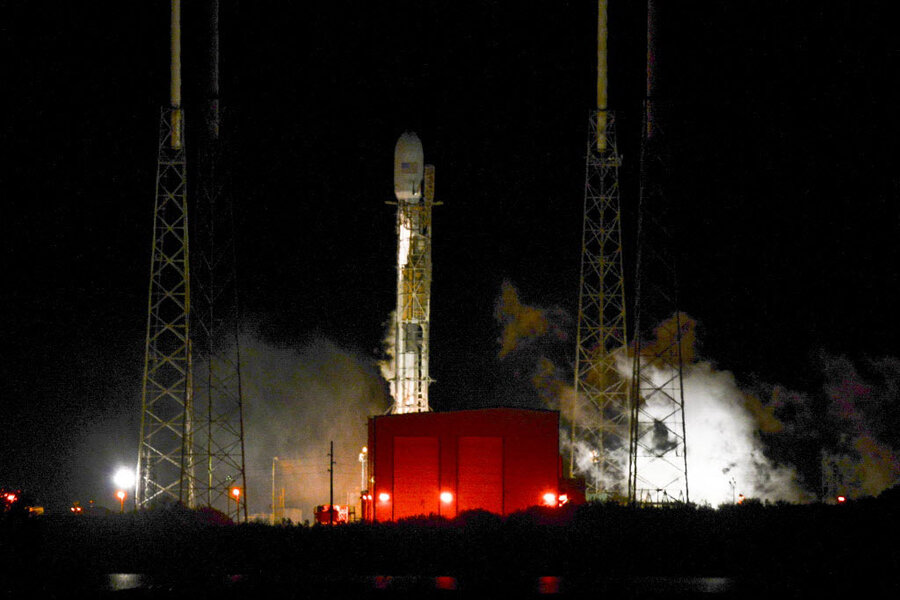Third launch scrapped in a week: Is SpaceX failing or just innovating?
Loading...
For SpaceX’s Falcon 9 rocket, the third time was not the charm.
After calling off the launch of a telecommunications satellite into orbit aboard its Falcon 9 rocket twice last week, on Sunday SpaceX for the third time scrubbed the launch a few seconds before liftoff, citing a stray boat that wandered into a restricted zone east of SpaceX's Cape Canaveral Air Force Station launch site in Florida.
"Scrambling (helicopter) to get them to move," Elon Musk, SpaceX founder and chief executive officer, posted on Twitter at the first countdown to launch.
The rogue boat threw off the timing of the already precarious routine of chilling the liquid oxygen propellant the company is now using to fuel Falcon 9, and loading it onto the rocket within a short window before launch.
The company resumed the countdown a few minutes after US Air Force officers dealt with the boat, but aborted a few seconds before launch, again because of technical problems with the propellant.
"Launch aborted on low thrust alarm. Rising oxygen temps due to hold for boat and helium bubble triggered alarm," Mr. Musk posted on Twitter after the countdown stopped the second time.
The problem in all three cases seems to be with a new feature of the Falcon 9: cryogenic propellant, liquid oxygen mixed with a type of kerosene and nearly frozen to make it more dense, and thus compact. This technique aims to give the rocket more power to carry heavier loads, and makes room for more fuel to ensure that the rocket can return to Earth for successful landing, a major goal – and hurdle – for SpaceX and the rest of the space-travel industry.
Though the repeated attempts and failures are a normal part of scientific and technological innovation, SpaceX’s rocket challenges are more public than their competitors’, who are paying attention and weighing in.
George Sowers, vice president of advanced concepts and technologies at United Launch Alliance in Denver, a joint aerospace venture between between Lockheed Martin and The Boeing Company, in December responded on Twitter to SpaceX’s issues with the supercooled liquid oxygen: “That’s why we don’t bother. Lots of complexity for little gain,” according to Spaceflight Now.
And Stéphane Israël, the chief executive of Arianespace, a French aerospace company, told Spaceflight Now that the biggest challenge for SpaceX will be to innovate while serving its commercial satellite and NASA customers, with whom it has billions of dollars worth of cargo-delivery contracts.
“We have our own challenges obviously,” Dr. Israel told Spaceflight Now. “There was a former CEO of Arianespace and CNES — Frédéric d’Allest — a very impressive guy, who always said that in our business, it is a business where failure and success are the closest. One little thing can make a difference and change the outcome of the mission,” he said.
Falcon 9 has been attempting to deliver into orbit SES-9, a 12,000-pound hunk of machinery built by Boeing and owned by Luxembourg-based satellite operator SES. It is the heaviest load that a Falcon 9 rocket has yet tried to deliver, and SES’s largest satellite to provide high-speed Internet and television services to the Asia-Pacific region.
If Falcon 9 is able to drop off the satellite in space, a piece of the rocket, the launch booster, will break off and attempt another feat: to land about 10 minutes later on a barge about 400 miles off Florida's coast.
Figuring out how to land rockets back on Earth is critical to the future of space travel, the cost of which would be significantly reduced if rockets, like airplanes, could be used more than once.
SpaceX, based in Hawthorne, Calif., has not yet said when it would make its next attempt to launch the rocket, though it said it would be no earlier than Tuesday.
This report uses material from Reuters.








